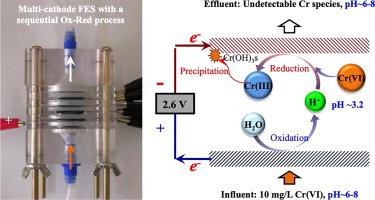Chemical Engineering Journal ( IF 15.1 ) Pub Date : 2020-11-05 , DOI: 10.1016/j.cej.2020.127622 Hai Liu , Guipeng Tian , Wenyi Wang , Jiachunxiu Zhang , Tianshu Wu , Xinye Ni , Yin-Hu Wu

|
Cr(VI) reduction to Cr(III) and subsequent Cr(III) precipitation is an extensively employed strategy to treat Cr(VI)-contaminated wastewater, which generally generates large volumes of sludge that need expensive disposal, and requires high chemical cost for pH adjustment. Herein, flow-through electrode system (FES) with a sequential oxidation-reduction process was employed to simultaneously reduce Cr(VI) and in-situ precipitate Cr(III), thereby simplifying the treatment processes and providing potentials to recollect Cr resource. The influent (10 mg/L Cr(VI)) with near neutral pHs (6-8) was first oxidized by the anode with H+ ions generation via H2O oxidation, leading to the anode-treated effluent turned into strong acidic with pH below 3.5. Subsequently, under acidic condition, the Cr(VI) species were prone to reduce to Cr(III) on the cathode. The multi-cathode FESs (1A+nC) equipped with one counter anode (1A) and multiple cathodes (nC) were constructed to enhance the Cr(VI) reduction by providing more cathode reactive sites and in-situ Cr(III) precipitation by maintaining near neutral effluent pHs. The flow-through flux and applied voltage were optimized to be 500 L/h/m2 and 2.6 V, under which Cr species were undetectable in effluent of 1A+4C FES within continuous operation time of 30 min. Regenerating the Cr(OH)3-passivated CFF electrodes and recollecting the Cr waste resource were easily accomplished by using a small volume of acidic solution with reversed applied voltage. This study suggested that carbon fiber-based FES with a sequential oxidation-reduction process can be a feasible approach for remediation and recovery of Cr(VI) contamination.
中文翻译:

碳纤维基流通电极系统(FES)用于在中性pH值附近通过Cr(VI)还原和原位吸附Cr(III)沉淀物去除Cr(VI)
将Cr(VI)还原为Cr(III)和随后的Cr(III)沉淀是处理被Cr(VI)污染的废水的一种广泛采用的策略,该废水通常会产生大量污泥,需要昂贵的处理费用,并且需要较高的化学费用pH调节。本文中,采用具有顺序氧化还原工艺的流通电极系统(FES)来同时还原Cr(VI)和原位沉淀Cr(III),从而简化了处理过程并提供了回收Cr资源的潜力。具有接近中性pH(6-8)的进水(10 mg / L Cr(VI))首先被阳极氧化,并通过H 2产生H +离子。O氧化,导致阳极处理的废水变成强酸性,pH值低于3.5。随后,在酸性条件下,Cr(VI)物种易于在阴极还原为Cr(III)。构造具有一个反阳极(1A)和多个阴极(n C)的多阴极FES(1A + n C),以通过提供更多的阴极反应位和就地Cr(III)沉淀来增强Cr(VI)还原通过保持接近中性的废水pH值。流通通量和施加的电压经过优化,分别为500 L / h / m 2和2.6 V,在此条件下,在30分钟连续运行时间内1A + 4C FES的出水中检测不到Cr物种。再生Cr(OH)3钝化的CFF电极和Cr废料的回收很容易通过使用少量反向施加电压的酸性溶液来完成。这项研究表明,具有顺序氧化还原工艺的碳纤维基FES可能是修复和回收Cr(VI)污染的可行方法。

























 京公网安备 11010802027423号
京公网安备 11010802027423号